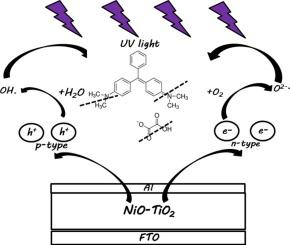Chemical Engineering Research and Design ( IF 3.7 ) Pub Date : 2020-07-02 , DOI: 10.1016/j.cherd.2020.06.027 Moushumi Dutta Purkayastha , Joydeep Datta , Partha Pratim Ray , Nisha Singh , Gopala Krishna Darbha , Shanku Denrah , Mitali Sarkar , Tapas Pal Majumder , Dipankar Ghosh

|
NiO-TiO2 (TN) nanocomposite is synthesized from an assembly of p-type nickel oxide (NiO) and n-type titanium oxide (TiO2) in an ultrasound assisted operation. Transmission electron microscopy (TEM) demonstrates the existence of hexagonal particles in the nanocomposite. Dynamic light scattering (DLS) measurements show stable TN nanoparticles (NPs) at a negative zeta potential (−18.5 ± 0.8 mV). The nanocomposite is tested for its catalytic activity towards degrading malachite green (MG), a known water toxicant and methylene blue (MB) under ultraviolet (UV) irradiation. Response surface methodology (RSM) is employed to optimise the influence of significant variables such as initial dye concentration, catalyst dose and time. Their mutual interactions are mapped by response surface and contour plots and correlated with degradation process by a designed model. The best photocatalytic efficiency (87%) is observed at an optimised concentration of 5 ppm dye with 10 ppm catalyst. The presence of inorganic ions and organic matter hardly affected the aggregate size of TN but caused a decline in photoactivity. The catalyst is found effective even in real water system (Hooghly River). A (Fluorine doped tin oxide) FTO/TN/Al heterojunction is fabricated. TN showed enhanced carrier mobility (1.03.10−4 m2V-1s-1) and low transit time (1.76.10-6 s) evaluated using space charge limited current (SCLC) theory. The nanocomposite appears suitable for energy preservation and environmental applications.
中文翻译:

模拟pn镍钛氧化物纳米复合材料的光催化行为
NiO-TiO 2(TN)纳米复合材料是由p型氧化镍(NiO)和n型氧化钛(TiO 2)进行超声辅助操作。透射电子显微镜(TEM)证实了纳米复合材料中六角形颗粒的存在。动态光散射(DLS)测量显示出负ζ电位(-18.5±0.8 mV)下稳定的TN纳米颗粒(NPs)。测试该纳米复合材料在紫外(UV)辐射下降解孔雀石绿(MG),一种已知的水毒物和亚甲基蓝(MB)的催化活性。使用响应表面方法(RSM)来优化重要变量的影响,例如初始染料浓度,催化剂剂量和时间。它们之间的相互作用通过响应面和轮廓图进行映射,并通过设计模型与降解过程相关。在5 ppm染料和10 ppm催化剂的最佳浓度下,观察到最佳的光催化效率(87%)。无机离子和有机物的存在几乎不会影响TN的总尺寸,但会导致光活性下降。发现该催化剂甚至在真实的水系统(Hooghly River)中也有效。制备(氟掺杂的氧化锡)FTO / TN / Al异质结。TN显示出增强的载流子迁移率(1.03.10−4 m 2 V -1 s -1)和低传输时间(1.76.10 -6 s)使用空间电荷限制电流(SCLC)理论评估。纳米复合材料似乎适合节能和环保应用。











































 京公网安备 11010802027423号
京公网安备 11010802027423号